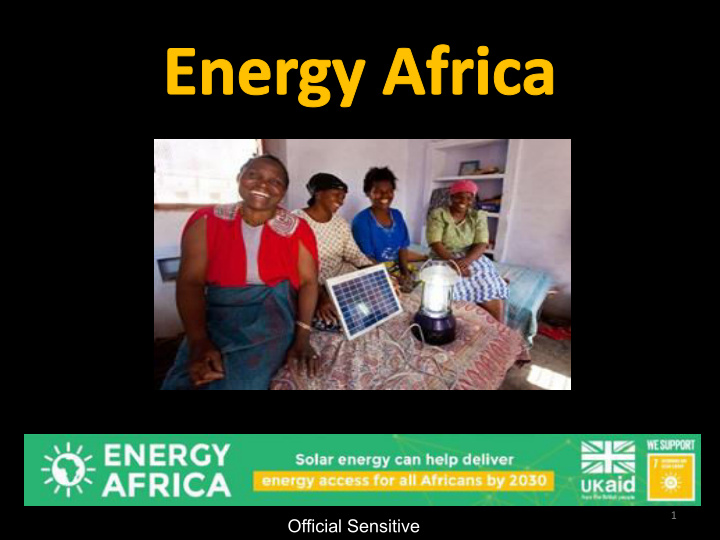



1 Official Sensitive
Contents 1. Energy Africa: What? 2. Energy Africa: Why? 3. Energy Africa: How? 4. Energy Africa: Compact Case Study 5. Energy Africa: Next Steps 2
3
E�ergy Afri�a is… A strategic DFID initiative to accelerate the expansion of the household solar market in SSA 4
5
1. Over 600 Million people in Sub Saharan Africa do not have a��ess to ele�tri�ity, that’s arou�d 2 in 3. 2. Afri�a’s poorest �a� pay up to 80 times more for energy than many people in the UK and other developed countries. 3. Grid coverage in Africa unlikely to ever exceed 40% due to population distributions. 4. Lack of energy access stifles development and restricts economic development at its grass roots growth 5. BAU will mean universal electricity will not be achieved until 2080. 6
Co-benefits across the development spectrum Economic Climate Change Development Energy Africa is providing Families that use kerosene spend Solar Household 10% of household income for 4 Solutions and renewable energy, supporting hours of light at night, whilst climate smart families with a solar light spend development. Less only 2% of household income on Bringing forward the Kerosene use will have a lighting, saving $60 a year positive impact on delivery of Global Goal 7 climate change. in Africa from 2080 to 2030 Reaching the Women & Girls Poorest Energy Africa will reduce household Energy Africa is ensuring energy poverty which that no-one is left behind through its remote rural is a significant focus and reaching the �o�strai�t to wo�e�’s 50%-60% who will stay economic Education off the grid. empowerment. Health Household solar Solar Household solutions provides more time reduce indoor air pollution, and light to study at danger of fire and eye night improving irritation. educational performance 7
8
Energy Africa: How Promote global quality standards and protect consumers Mobilise Ease access to finance for consumer- businesses finance through across the value mobile money chain Facilitate the import of household solar equipment Remove government policy uncertainty Approach • Generate policy, regulatory and market shifts to rapidly accelerate SHS growth by developing and agreeing bespoke Energy Africa Compacts with African governments. • Co-ordinate support from DFID and partners through central and in-country programming and TA to assist implementation of compacts • Firms use early stage funding from DFID and partners to develop and seed businesses • Firms that have proved model eligible for scale up funding to expand into new geographies
10
Sierra Leone: Energy Africa Case Study Key elements of the Compact: • Supply �asi� power to all of Sierra Leo�e’s populatio� withi� 9 years ��y 2025� • Introduced clauses in the 2016 Finance Act which eliminates import duties for qualifying solar that meet IEC global quality standards • A list of qualifying products e�a�le �gree� la�e� i�portatio� status will �e added to this act in secondary legislation • Sierra Leone will also develop a long term Rural Electrification and Market Development Framework (currently only have short term plan) • Private sector partners will form the first ever private sector trade association – the Renewable Energy Association of Sierra Leone ( REASL ). • Coordinated support: • Rural Electrification in Sierra Leone - New £35m DFID mini-grid programme • SOBA – DFID programme working directly with solar companies expanding in SL • Partner support from: the World Bank, BBOXX, Adam Smith, Power for ALL 11
12
Recommend
More recommend